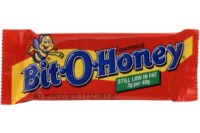A new better-for-you-candy company called Behave launched this week online. Actually, that’s not quite right. The branding on the minimalist packaging actually reads, “Behave.”
And the name, with the strikethrough, is the perfect way to sum up the juxtaposition of the brand — a healthy indulgence. Or, as the company’s tag line puts it, “We’re good so you don’t have to be.”
Founder Mayssa Chehata said she wanted to create a delicious candy that people could eat guilt-free. Something that made them feel like they were “behaving” while breaking the rules.
“I really do think of myself as the target consumer,” said Chehata, who is 28. “I’m such a candy lover, I’ve always been a huge candy fiend. As you get older, as you get to your mid 20s, you start reevaluating the things you’re eating. That experience of enjoying candy just really flipped. I always felt sick after, I always felt guilty after.”
Over the last couple years, she searched for a candy she could feel good about eating. But when she failed to find it, she decided to create it herself. Well, not exactly by herself. Chehata reached out to Elizabeth Falkner, a celebrity chef who had appeared on the Food Network, to create the perfect recipe — something that was both healthy and delicious.
“When I set out to make healthier candy, I knew they had to taste amazing,” Chehata said. “That’s why I approached Elizabeth (rather than an R&D lab) to develop recipes that are as good as your favorite classics.”
From the start they knew they wanted to launch a gummy bear.
“People who love gummies, like LOVE gummies,” Chehata said, adding that she’s one of those people.
But they still had to find the right formulation.
While they worked to create a reduced-sugar product, they wanted to avoid using sugar alcohols, but they didn’t want to use stevia either. So they decided on monk fruit as the sweetener, which Chehata says she likes the taste of best.
After that came flavors. They taste-tested more than 100 different varieties in the kitchen, and eventually choose lychee, passionfruit and raspberry.
The final result was sweet and sour versions of gummy bears made with ingredients like chicory root fiber, kosher gelatin, monk fruit extract, natural flavors and fruit and vegetable juice (for color), among other things.
And they are surprisingly healthy. Each 1.8-oz. bag contains only 3 grams of sugar, 6 grams of net carbs and 90 calories. They are sold in boxes of six bags on the website, at $30 for a one-time purchase.
“I wanted to create a gummy bear that tastes juicer, with better texture and more interesting flavors,” said Falkner, who’s now Behave’s head of candy. “Better-for-you shouldn't mean boring! After lots of testing, the end product speaks for itself."
Now that they had a final confection, they had to create packaging and branding.
Chehata drew on her experiences working at companies like Daily Harvest, Uber and SoulCycle to come up with the marketing. And the end result was a minimalist design with a pastel lavender, muted lime green and classic blue color palette.
“I saw a lot of candy in the candy aisle that was very kid forward, very much marketed toward children, and I feel like we had something to come in and offer something to the Millennial adult consumer,” she said.
While the product has launched 100 percent as direct-to-consumer, that wasn’t always the plan. But like most things these days, COVID-19 left its mark.
“We always had planned to launch direct-to-consumer, if you had asked me in March, we did have plans to be in some retail, focusing on the New York City market,” Chehata said. “We had to take a look back at that strategy and see if that makes sense. Ultimately we decided to hold off on retail, and I think the other thing we saw, we’re seeing so much consumer behavior shift to online.”
But the silver lining is that consumer shopping behavior has shifted dramatically since the start of the pandemic, leading more people to purchase food online.
“As much as the consumer behavior was already shifting to online shopping behavior, the lockdown and the pandemic, really forced consumers... to really turn to buying everything online,” she said.
Long-term the goal is to launch more products and to be available in multiple channels, but for now they are focused on building a community around the brand, both on the website and on social media platforms like Instagram, where the company’s bio reads, “Low-sugar candy that’s actually good — so you don’t have to be.”
“Community is going to be so important to us,” Chehata said. “Social media is such an important part of that. Being really active from a customer service perspective as well. There are humans behind this brand.”




